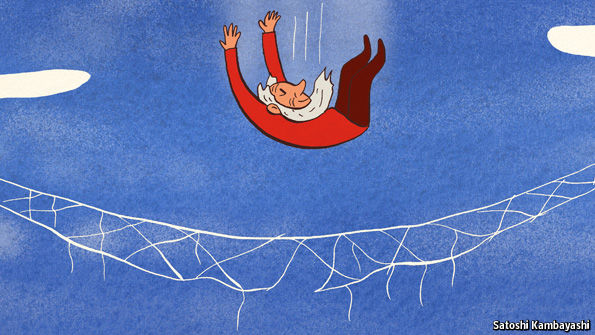Buttonwood
Age may well wither them
Americans are not saving enough for their retirement
.

EVERYONE knows that the baby-boomer generation is in the process of retiring, and that all those ex-hippies and punks can expect to live longer than the Americans who retired before them. But the financial challenge this poses is less well understood. Any lingering complacency ought to be exploded by two papers in the latest Journal of Retirement.
The first*, from the Centre for Retirement Research (CRR) at Boston College, estimates the proportion of 65-year-olds who will be able to retire without a big hit to their disposable income. Pensioners do not usually need as much money coming in as workers: for a start, they no longer need to save for retirement. The CRR estimates that 65-85% of their previous income is a reasonable “replacement rate”, depending on the type of household.
As well as private pensions, elderly Americans receive income from the federal government (in the form of Social Security, the public pension) and many earn money from their accumulated wealth, particularly by taking equity out of their houses. Even allowing for these sources of income, the CRR estimates that 52% of Americans may not be able to maintain their standard of living (which it defines as having an income that falls no more than 10% below the replacement rate).
Unsurprisingly, the biggest problems face those with no private pension at all: 68% of these Americans are expected to fall short. Those lucky enough to be covered by defined-benefit plans—in which pensions are linked to a worker’s salary—have the least difficulty: only 20% are deemed at risk. Of those in defined-contribution (DC) plans—in which workers receive whatever pension pot they have accumulated by retirement—53% probably will not reach the replacement rate.
The problem is that many people simply do not save enough in a DC pension. The combined contributions of employers and employees average just 11.3% of salary. This will not generate the same level of pension as a typical defined-benefit plan. The CRR found that the average retirement assets of those aged 50-59 were just $110,000 in 2013, slightly lower than in 2010.
This balance will improve over time, since DC plans are relatively new, but there is a long way to go. If pensioners take an (inflation-adjusted) 4% a year from their pot, they will need $250,000 just to generate an income of $10,000.
At least, you might think, Social Security will provide a basic income for the elderly. But the second paper**, by Sylvester Schieber, a former chairman of the Social Security Advisory Board, points out that there are holes in the safety net. Retirement income is based on an average of every worker’s highest 35 years of earnings. But if a worker was not in employment for the full 35 years—because of sickness, an inability to find work or time spent caring for children or other relatives—the missing years count as zeroes for the calculation.
Mr Schieber finds that people whose total careers lasted just 10-19 years comprise 8% of pensioners, but just over half of the poorest tenth of the elderly. Such workers could hardly have saved more for their retirement; they had barely adequate income in the first place.
That could be a looming problem, given Social Security’s finances. Payroll taxes on current workers no longer exceed the benefits paid out, prompting the government to tap the surplus of past years. On current projections, this will run out in 2034. After that, the cost of pensions could still be met mainly by contributions from workers. But the politicians of the day may be forced to consider benefit cuts.
Mr Schieber thinks the Social Security system is underfunded by around 25%. If an across-the-board benefit cut of that magnitude were applied, it would hit the poorest workers hardest, since they have few alternative sources of income. At present, a 25% benefit cut would reduce the income of the median pensioner by 12.3%. But the poorest tenth would lose 18.9% of their aggregate income.
So budding pension reformers will have to solve several problems simultaneously. First, they need to stabilise Social Security while protecting (and indeed enhancing) the incomes of the poorest. That should involve some combination of higher taxes, benefit cuts for the best-paid and greater saving in the middle rungs of the income ladder—at the same time as ensuring that people do not save too much too quickly, in case the impact on demand crashes the economy.
Good luck.
0 comments:
Publicar un comentario